D&MP Vortex86EX3 is a Twin Core x86 SoC for industrial applications with a master CPU and a Slave CPU, each capable of running an operating system independently, be it Windows 10 IoT, Linux, legacy OS like WinCE or DOS, or an RTOS like QNX.
Like its predecessors, such as the DM&P Vortex86EX2 or Vortex86DX3, the Vortex86EX3 – also written Vortex86 EX3 – supports older PCI and ISA interfaces, as well as more recent interfaces such as PCIe, and the usual serial, CAN Bus, and GPIO found in this type of processor. The Vortex86EX3 is the most powerful x86 SoC from the company so far, with two cores clocked at up to 1.2 GHz to 1.6 GHz.
The comparison table below lists the specifications and main features of the Vortex86DX3 (2015), Vortex86EX2 (2019), and the new Vortex86EX3.
| Feature | Vortex86DX3 | Vortex86EX2 | Vortex86EX3 |
|---|---|---|---|
| CPU frequency | 1.0GHz | 600MHz | 1.2GHz |
| Core | One | Two | Two |
| DRAM Bus | 32-bit DDR3 | 16-bit DDR3 | 32-bit LPDDR4 |
| DRAM ECC | No | Yes | Yes |
| GPU | 2D Engine VGA/LCD | N/A | N/A |
| LCD-Controller | N/A | Yes | Yes |
| HD-Audio | Yes | Yes | Yes |
| WatchDog | 2 | 2 | 2 |
| PCIe Bus | PCIe Gen1 x2 | PCIe Gen1 x2 | PCIe Gen2 x2 |
| ISA Bus | Yes | Yes | Yes |
| SPI Bus | 2 | 2 | 8 |
| USB | 4x Host | 2x Host | 4x Host, 1x Device |
| Serial ports | 9 | 10 | 10 |
| GPIO pins | Up to 88 | Up to 128 | Up to 160 |
| Ethernet | 1 | 2 | 2 |
| Storage | SATA + IDE/SD | 3x SD/eMMC | 2x SD/eMMC |
| Parallel port | 1 | 1 | 1 |
| CAN Bus | N/A | 2 | 3 |
| I2C | 2 | 2 | 8 |
| ADC | 11-bit 8 channels | 12-bit 16 channels | 12-bit 16 channels |
| Package size | 51 x 31 mm | 19 x 19 mm | 17 x 17 mm |
| Package type | 720 pins Ball BGA | 441 pins Ball BGA | 627 pins Ball BGA |
| Temperature range | -40 ~ +85°C | -40 ~ +85°C | -40 ~ +85°C |
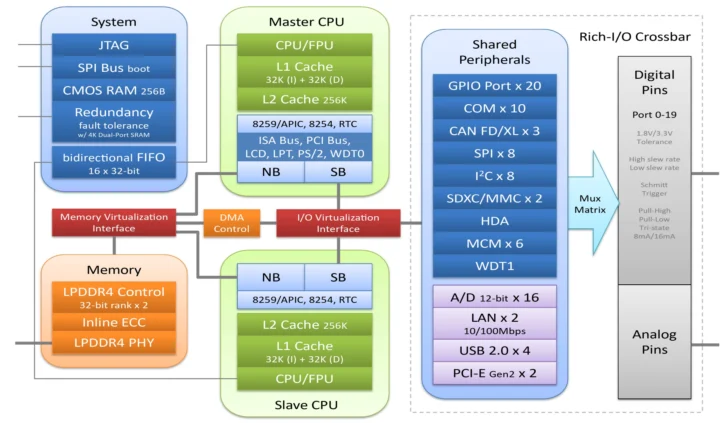
The Vortex86EX3 is not listed on the Vortex86.com website yet, and instead, I found it through an email from ICOP Technology with limited details after the solution was showcased at Computex 2025. After a little more research, I found a LinkedIn post from Embedded World 2025 and some extra details on a German distributor website.
The image below shows a diagram where each CPU has its own BIOS, operates independently, but both share the LPPDR4 memory and all I/Os.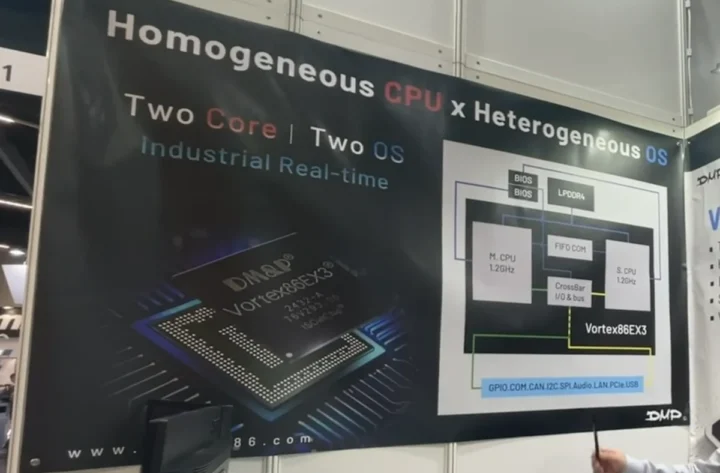
Supported operating systems are Windows 10, WinCE 5, 6, 7, Linux 2.x to 6.6, QNX 7.0, RTOS-32, and DOS. The Yocto Project build system is also listed. ICOP Technology and DM&P showcased a Vortex86 EX3 board running Linux (Debian) and Windows Embedded Compact 7 at the same time.
I could not find information about the board, it’s probably a development/reference board for the new x86 SoC. That’s all I could find, and there’s no product page for the Vortex86EX3 at this time.

Jean-Luc started CNX Software in 2010 as a part-time endeavor, before quitting his job as a software engineering manager, and starting to write daily news, and reviews full time later in 2011.
Support CNX Software! Donate via cryptocurrencies, become a Patron on Patreon, or purchase goods on Amazon or Aliexpress. We also use affiliate links in articles to earn commissions if you make a purchase after clicking on those links.


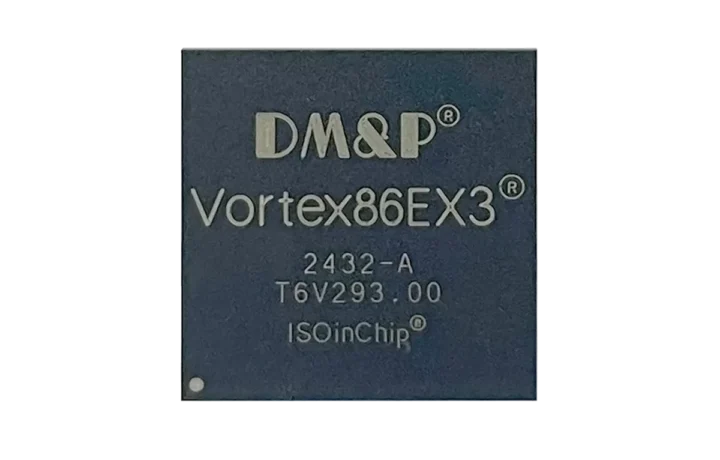
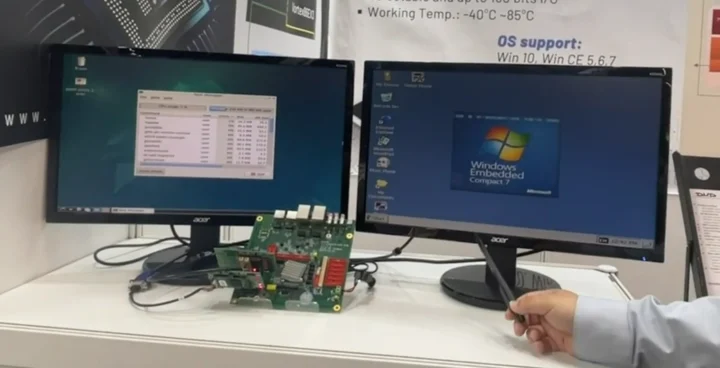
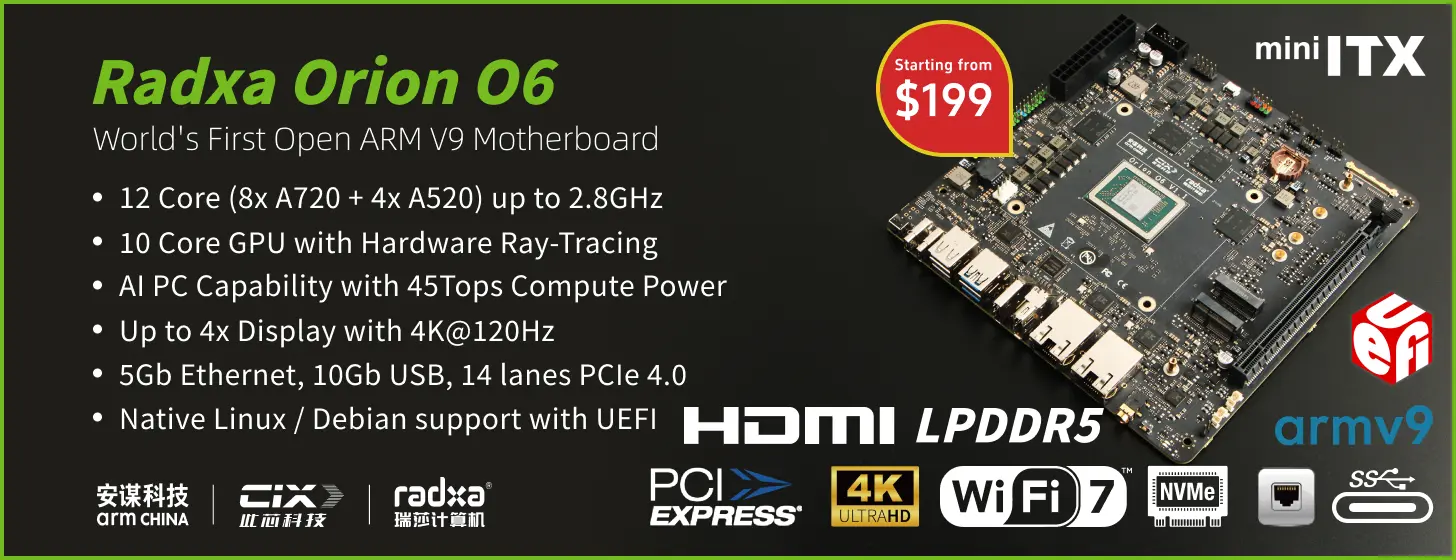


I think they were already showing information about the EX3 at EmbeddedWorld last year, but the demo was new this year. At least for EX2, the two cores are quite different, and only one of them is the newer “Emkore” design with SSSE3.
The SoC platform and CPU core apparently comes from RDC, with DM&P being the most prominent but not the only licensee. Here are some more bits I found about RDC, its other x86-32/x86-64 cores and one more licensee:
https://www.rdc.com.tw/?route=home/emk
http://www.xlichip.com/EmkorexinpianzuAL913/
https://forums.anandtech.com/threads/rdc-semiconductors-x86-64-thread.2623500/
Seems its a derivative of the old sis x86 cpus
As far as I can tell, only the first generation “Vortex86” SoC (M6127D) was a rebrand of SIS 551 (Rise mP6 core), the second chip “Vortex86SX” had a completely different and much slower CPU core from RDC that implemented an i486SX compatible instruction set, similar to RDC R321x.
The later DX/MX/EX/DX2/DX3/EX2 models each subsequently introduce CPU features after the 20 year patent expiry (tsc, cx8, mmx, cmov, sse, sse2, sse3). The mP6/SIS lineage is often cited, but it seems more likely to me that these are all cores by RDC that have a different lineage. The “Emkore” cores are described as having a six-stage RISC pipeline, which would make them more like a PentiumM or AMD K6 than the mP6 that seems to directly execute x86 instructions like a P5/Atom or Centaur/Via core.
CAN XL? Really? That would be one of the first XL implementations, right?
So these chips are only intended for industrial applications, right? No chance for low cost consumer x86 SBCs for running DOS?
There was the 86Duino Zero a few years ago. It might still be sold.
https://www.cnx-software.com/2013/11/27/39-86duino-zero-is-an-x86-arduino-compatible-board-that-supports-dos-windows-and-linux/
There’s also the Pixel x86 for retrogaming:
https://pixelx86.com/products